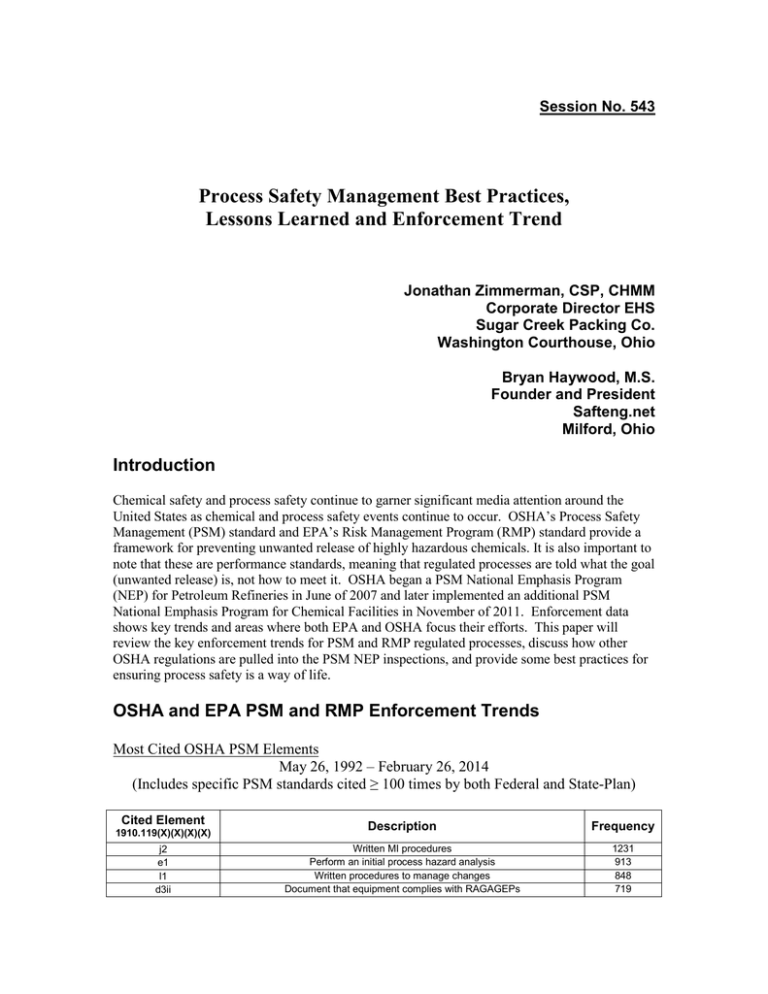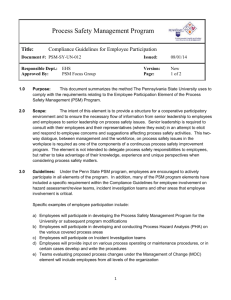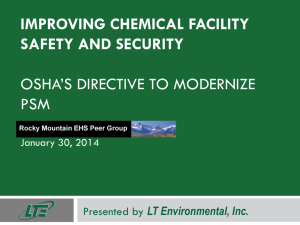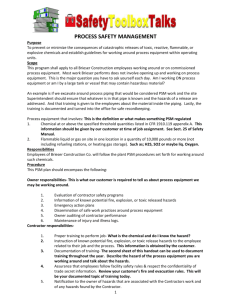Get PDF - OnePetro
advertisement

Session No. 543 Process Safety Management Best Practices, Lessons Learned and Enforcement Trend Jonathan Zimmerman, CSP, CHMM Corporate Director EHS Sugar Creek Packing Co. Washington Courthouse, Ohio Bryan Haywood, M.S. Founder and President Safteng.net Milford, Ohio Introduction Chemical safety and process safety continue to garner significant media attention around the United States as chemical and process safety events continue to occur. OSHA’s Process Safety Management (PSM) standard and EPA’s Risk Management Program (RMP) standard provide a framework for preventing unwanted release of highly hazardous chemicals. It is also important to note that these are performance standards, meaning that regulated processes are told what the goal (unwanted release) is, not how to meet it. OSHA began a PSM National Emphasis Program (NEP) for Petroleum Refineries in June of 2007 and later implemented an additional PSM National Emphasis Program for Chemical Facilities in November of 2011. Enforcement data shows key trends and areas where both EPA and OSHA focus their efforts. This paper will review the key enforcement trends for PSM and RMP regulated processes, discuss how other OSHA regulations are pulled into the PSM NEP inspections, and provide some best practices for ensuring process safety is a way of life. OSHA and EPA PSM and RMP Enforcement Trends Most Cited OSHA PSM Elements May 26, 1992 – February 26, 2014 (Includes specific PSM standards cited ≥ 100 times by both Federal and State-Plan) Cited Element 1910.119(X)(X)(X)(X) j2 e1 l1 d3ii Description Frequency Written MI procedures Perform an initial process hazard analysis Written procedures to manage changes Document that equipment complies with RAGAGEPs 1231 913 848 719 c1 f1 j5 g1i e5 N f3 j4i g3 Written plan of action regarding employee participation Develop and implement written operating procedures Correct deficiencies in equipment that are outside acceptable limits Trained in an overview of the process and in the operating procedures Establish a system to promptly address the PHA team's findings and recommendations Emergency planning and response (.38 and .120) Annual certification of Operating Procedures Inspections and tests shall be performed on process equipment Training documentation (means used to verify) 673 671 620 598 588 527 511 480 442 o1 Certify that they have evaluated compliance with the provisions of this section at least every three years 416 f1i d3iB Steps for each operating phase Piping and instrument diagrams (P&ID's) 397 376 f4 Develop and implement safe work practices to provide for the control of hazards during operations (LOTO, PRCS, LB, Controlled Access) 366 d3i j4iv d j4iii j4ii g2 j3 h2i e3v c2 o4 e3i f1iD e6 d2i d3iD f1ii e3vi e3iii m1 h2v Information pertaining to the equipment in the process Document each inspection and test that has been performed on process equipment Complete a compilation of written process safety information before conducting any process hazard analysis Frequency of inspections and tests of process equipment shall be consistent with applicable manufacturers' recommendations and RAGAGEPs Inspection and testing procedures shall follow RAGAGEPs Refresher training Training for process maintenance activities Obtain and evaluate information regarding the contract employer's safety performance and programs Facility siting Consult with employees and their representatives on the conduct and development of process hazards analyses and on the development of the other elements of process safety management Promptly determine and document an appropriate response to each of the findings of the compliance audit, and document that deficiencies have been corrected PHA shall address the hazards of the process Emergency shutdown including the conditions under which emergency shutdown is required, and the assignment of shutdown responsibility to qualified operators to ensure that emergency shutdown is executed in a safe and timely manner At least every five (5) years after the completion of the initial process hazard analysis, the process hazard analysis shall be updated and revalidated Information concerning the technology of the process Relief system design and design basis Operating limits Human factors Engineering and administrative controls applicable to the hazards and their interrelationships such as appropriate application of detection methodologies to provide early warning of releases Investigate each incident which resulted in, or could reasonably have resulted in a catastrophic release Periodically evaluate the performance of contract employers in fulfilling their obligations i1 Perform a PSSR for new facilities and for modified facilities when the modification is significant enough to require a change in the PSI l4 If a change covered by this paragraph results in a change in the PSI, the PSI shall be updated accordingly e3iv PHA shall address the consequences of failure of engineering and administrative controls 360 319 296 294 266 256 255 248 234 228 226 224 220 196 187 185 182 180 153 151 146 143 140 135 h2iv Develop and implement safe work practices to control the entrance, presence and exit of contract employers and contract employees in covered process areas 133 f1iiiB Precautions necessary to prevent exposure, including engineering controls, administrative controls, and PPE 131 l3 Operators, maintenance, and contract employees whose job tasks will be affected by a change shall be informed of, and trained in, the change prior to start-up of the process or affected part of the process 127 h2ii Inform contractors of the known potential fire, explosion, or toxic release hazards related to the contractor's work and the process 120 d2iE Evaluation of the consequences of deviations, including those affecting the safety and health of employees 119 f1ib d2iD l5 f1iv m5 h2iii TOTAL Normal operations Safe upper and lower limits for such items as temperatures, pressures, flows or compositions 117 115 Change results in a change in the operating procedures or practices required by paragraph (f) of this section, such procedures or practices shall be updated accordingly 114 Safety systems and their functions Establish a system to promptly address and resolve the incident report findings Explain to contract employers the applicable provisions of the emergency 114 110 106 17,006 Note: the 17,006 PSM citations represent 85% of all OSHA PSM citations (20,100) Table 1. Citations Sorted by Frequency Cited PSM Standard 1910.119(X)(X)(X)(X) c1 c2 d d2i d2iD d2iE d3i d3iB d3iD d3ii e1 e3i e3iii e3iv e3v e3vi e5 Description Frequency Written plan of action regarding employee participation Consult with employees and their representatives on the conduct and development of process hazards analyses and on the development of the other elements of process safety management 673 Complete a compilation of written process safety information before conducting any process hazard analysis Information concerning the technology of the process Safe upper and lower limits for such items as temperatures, pressures, flows or compositions Evaluation of the consequences of deviations, including those affecting the safety and health of employees Information pertaining to the equipment in the process Piping and instrument diagrams (P&ID's) Relief system design and design basis Document that equipment complies with RAGAGEPs Perform an initial process hazard analysis PHA shall address the hazards of the process Engineering and administrative controls applicable to the hazards and their interrelationships such as appropriate application of detection methodologies to provide early warning of releases PHA shall address the consequences of failure of engineering and administrative controls Facility siting Human factors Establish a system to promptly address the PHA team's findings and recommendations 228 296 187 115 119 360 376 185 719 913 224 153 135 234 180 588 e6 At least every five (5) years after the completion of the initial process hazard analysis, the process hazard analysis shall be updated and revalidated 196 f1 f1i Develop and implement written operating procedures Steps for each operating phase 671 397 f1ib Normal operations Emergency shutdown including the conditions under which emergency shutdown is required, and the assignment of shutdown responsibility to qualified operators to ensure that emergency shutdown is executed in a safe and timely manner Operating limits Precautions necessary to prevent exposure, including engineering controls, administrative controls, and PPE Safety systems and their functions Annual certification of Operating Procedures Develop and implement safe work practices to provide for the control of hazards during operations (LOTO, PRCS, LB, Controlled Access) 117 g1i Trained in an overview of the process and in the operating procedures 598 g2 g3 Refresher training Training documentation (means used to verify) 256 442 h2i Obtain and evaluate information regarding the contract employer's safety performance and programs 248 f1iD f1ii f1iiiB f1iv f3 f4 h2ii h2iii Inform contractors of the known potential fire, explosion, or toxic release hazards related to the contractor's work and the process Explain to contract employers the applicable provisions of the emergency action plan 220 182 131 114 511 366 120 106 h2iv Develop and implement safe work practices to control the entrance, presence and exit of contract employers and contract employees in covered process areas 133 h2v Periodically evaluate the performance of contract employers in fulfilling their obligations 146 i1 Perform a PSSR for new facilities and for modified facilities when the modification is significant enough to require a change in the PSI 143 j2 j3 j4i Written MI procedures Training for process maintenance activities Inspections and tests shall be performed on process equipment 1231 255 480 j4ii Inspection and testing procedures shall follow RAGAGEPs 266 j4iii Frequency of inspections and tests of process equipment shall be consistent with applicable manufacturers' recommendations and RAGAGEPs 294 j4iv Document each inspection and test that has been performed on process equipment 319 j5 l1 l3 l4 l5 m1 m5 N Correct deficiencies in equipment that are outside acceptable limits Written procedures to manage changes Operators, maintenance, and contract employees whose job tasks will be affected by a change shall be informed of, and trained in, the change prior to start-up of the process or affected part of the process If a change covered by this paragraph results in a change in the PSI, the PSI shall be updated accordingly Change results in a change in the operating procedures or practices required by paragraph (f) of this section, such procedures or practices shall be updated accordingly Investigate each incident which resulted in, or could reasonably have resulted in a catastrophic release Establish a system to promptly address and resolve the incident report findings and recommendations Emergency planning and response (.38 and .120) 620 848 127 140 114 151 110 527 o1 Certify that they have evaluated compliance with the provisions of this section at least every three years 416 o4 Promptly determine and document an appropriate response to each of the findings of the compliance audit, and document that deficiencies have been corrected 226 Table 2. Citations Sorted by PSM Element PSM Inspection History Summary (May 26, 1992 to February 26, 2014) 1 Total Number of PSM Inspections 2 …………………………………………….…3,721 Total Number of Violations………………………………………………………..20,100 Total Initial Penalty………………………………………………………......$93 Million Total Number of CHEM NEP Inspection (Opened Nov. 2011 to 2/26/14)….………890 Total Number of Refinery NEP Inspections (opened as of 4/4/2013)……..…………74 Data Source: OSHA Office of Statistics EPA’s General Duty Clause Section 112(r)(1) of the Clean Air Act states the following: It shall be the objective of the regulations and programs authorized under this subsection to prevent the accidental release and to minimize the consequences of any such release of any substance listed or any other extremely hazardous substance. The owners and operators of stationary sources producing, processing, handling or storing such substances have a general duty to identify hazards which may result from such releases using appropriate hazard assessment techniques, to design and maintain a safe facility taking such steps as are necessary to prevent releases, and to minimize the consequences of accidental releases which do occur. Many facilities put too much attention and effort into getting below or staying below the regulated thresholds thinking that they can avoid PSM and RMP regulation all together. But as the above general duty clause makes clear having a fully implemented process safety management program easily complies with the general duty requirements. Multiple facilities in the past 6 months have received RMP general duty citations. Facilities storing 9,000 pounds of ammonia and 4,675 gallons of flammable liquids both below regulatory thresholds have had common citations containing this type of language: • • • • • 1 2 Failed to provide protections consistent with applicable industry codes and standards No hazard analysis performed using industry recognized hazard assessment techniques Failure to meet Recognized and Generally Accepted Good Engineering Practice (RAGAGEP) Inadequate signs and labels Lack of Documentation Includes Federal and State-Plan states Defined as an inspection that included at least 1 PSM violation Importance of the Three-year Compliance Audit Both OSHA and EPA require every covered process to conduct a compliance audit at a minimum of every three years. Regulated entities can look at these audits as a necessary evil or as another check box to mark off, worrying more about minimizing the findings and painting a rosy picture. The other view of compliance audits looks at them as valuable efforts to test the process safety system with an opportunity to fix the identified issues and be better prepared for the next OSHA or EPA inspection. The latter perspective may mean bringing in someone with a true process safety background from outside your particular industry. An analysis of OSHA PSM inspections shows a litany of other OSHA regulations being cited and looked at as part of the inspection process. These additional regulations are intertwined with the process safety system and it’s elements. Adding an analysis of these additional regulations as part of the compliance audit can differentiate a Great audit from a “so-so” audit. These include: 1. Fixed Industrial Stairs: Anytime a worker has to travel to an upper or lower area at least once per shift “stairs” must be provided. Example would be locating equipment for daily rounds on the roof. 2. Personal Protective Equipment (PPE): In flammable processes the certified PPE Hazard Assessment should be identifying Flame Retardant Clothing (FRC) as a necessary piece of PPE. 3. Respiratory Protection: In all aspects of chemical process safety (operations, maintenance, and emergency response) respiratory protection plays a large role in protecting workers. 4. Design and construction requirements for exit routes and maintenance, safeguards, and operational features for exit routes. This includes evacuation maps, exit signs, emergency lighting, and alarm systems. These requirements apply not only to indoor operations, but to outdoor operations with catwalks and multiple levels. 5. PSM actually requires covered processes to have an emergency action plan that includes these six items: • Escape procedures and emergency escape routes • Procedures for employees who remain to operate critical plant operations • Procedures to account for all employees upon emergency evacuation • Rescue and medical duties • How fires and other emergencies are reported • Name or job title of person to contact with questions 6. For facilities with an established and organized emergency response team compliance with the Hazardous Waste Operations and Emergency Response (HAZWOPER) standard must be verified. 7. Permit-required confined space compliance is required by 29 CFR 1910.119(f)(4) and must be verified. If actual confined space operations are taking place during the audit they should be evaluated. At a minimum, closed permits from the past year should be audited. 8. As with PRCS, control of hazardous energy is spelled out as a safe work practice in 29 CFR 1910.119(f)(4). Training records, annual periodic inspections, machine specific procedures, and contractor lockout should all be evaluated. 9. Compressed air receivers, air compressors, boilers, and other utility/facility equipment. Are these systems part of the covered process or does the process safety depend on these utilities? If the answer is yes this equipment should be included in the three-year audit. 10. Powered industrial trucks and their use around covered process equipment must be reviewed and verified. Specific examples may be powered industrial trucks used in refrigerated warehouses where pipes and equipment can be impacted, scissor lift usage around equipment and pipes, or use of trucks in hazardous locations. Occupational Safety and Health Management Systems Every management system requires a cycle of Plan, Do, Check, Act (PDCA) as the late Dr. W. Edward Deming made popular and safety and health management systems are no different. According to various documents published on OSHA’s website a typical occupational safety and health management system has six core elements: • • • • • • Management Leadership Worker Participation Hazard Identification and Assessment Hazard Prevention and Control Education and training Program Evaluation and improvement A PSM and RMP program contains these six elements, creating a PDCA loop. Table 3 matches these six elements to the RMP or PSM element. Safety Management System Element PSM/RMP Element Management Leadership Management Commitment required under RMP - 40 CFR 68.1 Worker Participation Employee Participation Hazard Identification and Assessment Process Hazard Analysis Hazard Prevention and Control Process Safety Information, Operating Procedures, Contractor Safety, Pre-Start-Up Safety Review, Management of Change, Mechanical Integrity, Standard Operating Procedures, Hot Work, Emergency Planning and Response, and Incident Investigation Education and Training Training Program Evaluation and Improvement Compliance Audits Table 3. Management System Element Comparison Taking all of these management system elements into consideration along with the PDCA cycle and the crossover of the various OSHA regulations into the PSM standard a best practice for any regulated process would be to incorporate all safety policies and procedures into the established PSM system. Implementation of this best practice ensures that all safety documents and processes are controlled through the management of change process. One management system keeps all safety documentation organized, and in one place making any type of audit flow smoothly and efficiently. Conclusion Compliance with OSHA’s PSM and EPA’s RMP regulations is an important consideration for any facility that utilizes a highly hazardous chemical. Citations, penalties, and inspections are increasing in frequency and this fact conveys the importance of conducting thorough internal PSM/RMP audits that cover often overlooked OSHA requirements in addition to the required elements of a PSM/RMP program. Utilizing a PSM/RMP program as a safety management system can be a best practice any covered process can implement. Bibliography United States Environmental Protection Agency (EPA). 2014. Enforcement and Compliance History Online. United States Occupational Safety and Health Administration (OSHA). 2014. Office of Statistics. ________. 2014. Injury and Illness Prevention Programs.




